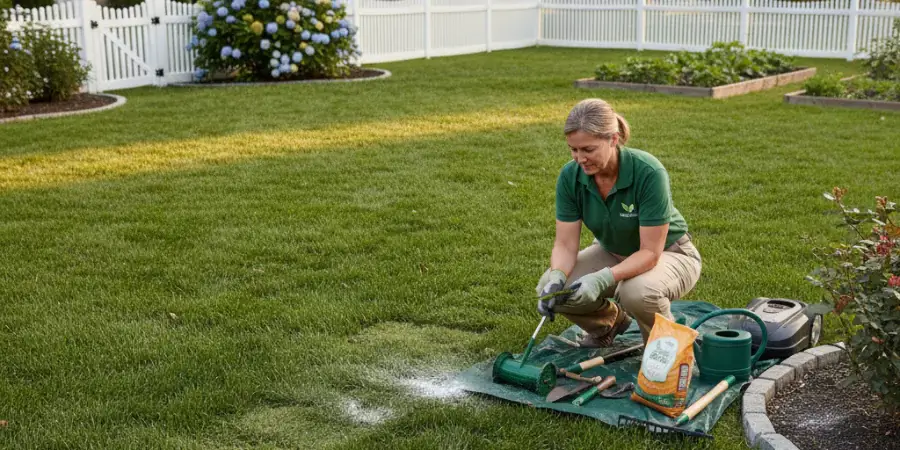A well-kept lawn makes a home look welcoming and gives you a place to relax and enjoy the outdoors. In Livingston, the warm climate and seasonal rain help grass grow green and thick. These same conditions can also lead to lawn diseases that weaken the turf and harm its appearance. Problems such as patchy spots, fading color, and thinning areas can spread quickly if they are not treated.
The best way to protect your lawn is to understand the causes of common diseases, notice the signs early, and treat them with the right methods. Getting help from Livingston lawn care services can make the process easier and more successful. This article will cover some of the most common diseases in the area, what causes them, and the best ways to stop and handle them successfully
Brown patch and how it damages your grass
Brown patch is a common problem during the warmer, more humid months in Livingston. It shows up as circular or irregular patches of brown grass surrounded by a darker edge. This disease is caused by a fungus that grows when nights are warm and moisture stays on the grass for too long. Giving too much water or watering in the evening can make the problem worse. Fixing this issue includes adjusting your watering schedule, improving air circulation, and using the right treatment when needed.
Dollar spot and what causes it
Dollar spot is named for the small, round, bleached patches it creates, which are about the size of a coin. A fungus causes this problem by attacking the grass blades and creating pale, dry spots. It tends to appear more when the lawn is low in nitrogen. Giving your lawn balanced nutrients and keeping your mower at the correct height will help stop this disease from spreading.
Gray leaf spot during warm seasons
Gray leaf spot appears as gray or tan spots with dark borders on grass blades. It grows quickly during hot and humid weather, which is common in Livingston summers. Lawns with too much thatch or poor drainage are more likely to develop this problem. Mowing regularly, reducing excess nitrogen, and improving water drainage are good ways to prevent it.
Red thread and what it means for your lawn
Red thread can be recognized by reddish or pinkish strands that appear on grass blades. This disease is more common when the lawn does not have enough nutrients. While it rarely kills grass completely, it makes the lawn look weak and patchy. The best way to manage red thread is to fertilize properly and keep up with a regular feeding schedule.
Simple steps to prevent lawn diseases
You can lower the risk of most lawn diseases with a few simple practices:
- Water deeply but less frequently, and do it early in the morning
- Make sure mower blades are sharp and do not trim the grass too low
- Feed your lawn based on its type and soil condition
- Aerate the soil to improve air movement and prevent compaction
- Remove thick thatch to keep moisture from building up
Why soil health matters
Strong soil helps grass grow deeper roots and stay healthy. In Livingston, clay soil can hold too much water, which encourages fungal growth and root problems. Adding compost or organic matter improves drainage and allows roots to spread better. Healthy soil gives grass the strength it needs to fight off diseases naturally. Regular testing of soil conditions helps ensure it has the right balance of nutrients for long-term lawn health.
The benefits of getting expert help for your lawn
Basic lawn care can be handled at home, but some problems need expert attention. A professional can spot diseases early, apply the correct treatment, and suggest ways to stop the issue from coming back. They can also create a care plan that keeps the lawn healthy through all seasons. Many people choose Livingston lawn care services to make sure their grass is cared for the right way. Working with trained specialists can also save time and prevent costly mistakes that might harm the lawn.
Maintaining your lawn in every season
The needs of a lawn change as the seasons change in Livingston. Warmer months may require more attention to fungal problems, while cooler months focus on building strength and recovery. Adjusting your care routine to match the weather, along with regular inspections, will help your lawn stay green and healthy all year.
Protecting your lawn from diseases means using preventive steps, recognizing problems early, and applying the right solutions. When grass is fed well, watered correctly, and cared for regularly, it can resist damage and recover quickly. Many homeowners rely on Livingston lawn care services for expert help and proven methods that keep their yards in top condition. With steady care and the right approach, your lawn can remain healthy, green, and free of disease.









